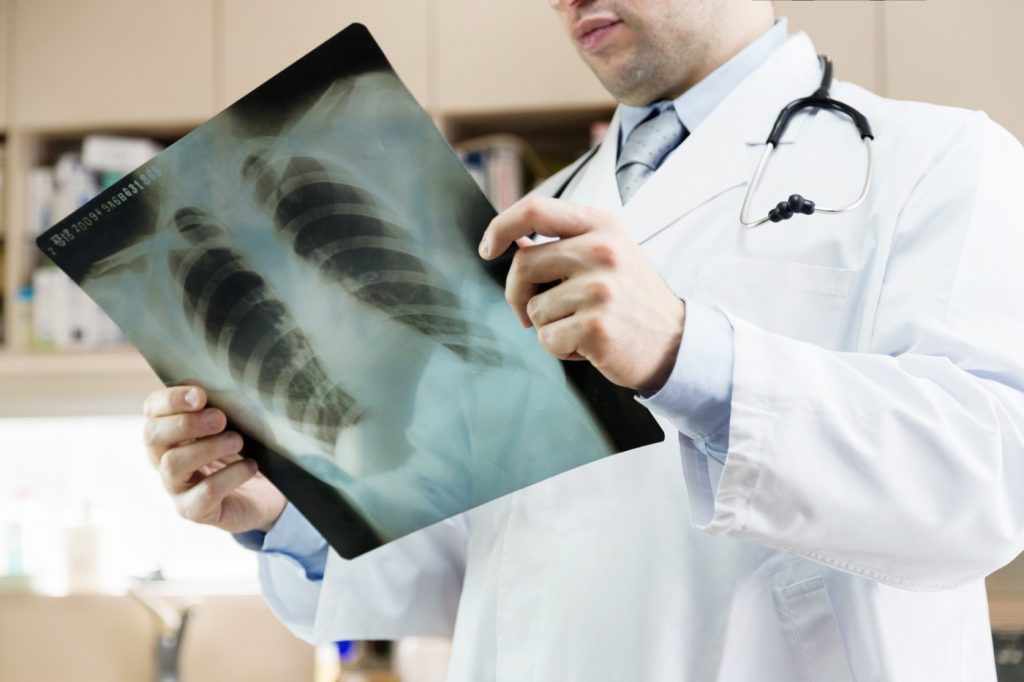Lung Ultrasound Reliable Option to Chest X-rays for Monitoring Children

Lung ultrasound is a safe and reliable bedside tool to detect atelectasis (partial lung collapse) early in children with neuromuscular diseases, including spinal muscular atrophy (SMA), a study suggests.
This radiation-free method could be used to monitor lung health and identify partial lung collapse in a patient group already highly exposed to radiation in clinical exams, its researchers noted.
They emphasized, however, that lung ultrasound should not replace radiological exams. Rather, it can be used to answer specific questions raised by doctors between regular chest X-ray examinations.
The study, “Lung ultrasound: A useful additional tool in clinician’s hands to identify pulmonary atelectasis in children with neuromuscular disease,” was published in the journal Pediatric Pulmonology.
Children with neuromuscular diseases, including SMA, are more susceptible than others to such respiratory complications as upper airway obstruction, aspiration (the entry of food or liquids into the lungs), recurrent infections, hypoventilation (shallow breathing), and atelectasis.
Atelectasis refers to the collapse or incomplete expansion of one or more areas in the lungs. When the lungs cannot fully expand and take in enough air, the blood may not receive enough oxygen. Low blood oxygen levels can lead to serious complications and, eventually, to respiratory failure.
“Respiratory impairment is the leading cause of morbidity and mortality in children with [neuromuscular diseases]; therefore, the early recognition of a lung injury, such as [atelectasis], is essential,” the researchers wrote.
Partial lung collapse is typically assessed via a chest X-ray, but alternative, radiation-free methods are being evaluated to lower patients’ exposure to radiation. This is particularly relevant for people with conditions such as SMA, already associated with a high frequency of radiological exams.
Lung ultrasound (LUS) is a low-cost, radiation‐free, non-invasive, and reliable method to assess lung abnormalities in real-time. Several studies have highlighted that LUS may be a more reliable diagnostic tool in children than in adults, due to their anatomical features. Some reports of its use in diagnosing lung diseases in children exist.
However, studies have not addressed the use of LUS in children with neuromuscular diseases.
A team of researchers in Rome compared the use of chest X-ray and LUS to detect the presence of partial lung collapse in pediatric patients with neuromuscular diseases.
The study involved 40 children (21 girls and 19 boys, median age 7.5), who underwent chest X-ray followed by LUS (both performed at bedside).
SMA type 1 (16 patients) was the most common neuromuscular disease affecting these children, followed by SMA type 2 (seven patients) and congenital myopathies (seven patients).
Simultaneous clinical conditions (comorbidities) were present in 62% of patients, with severe scoliosis (an abnormal curvature of the spine) being the most frequent (28%).
Results showed that 22 children (55%) had partial lung collapse. Chest X-ray was able to detect all cases of partial lung collapse, while LUS could detect it in 20 children — inconclusive results were obtained in two children due to severe scoliosis.
Partial lung collapse occurred more frequently in the left lower lobes of the lungs, and both methods identified more than one area of collapsed lung in five children.
A partial or complete agreement in results using LUS and chest X-ray were reported in 31 children (77.5%) and a disagreement in seven, four of which were positive for atelectasis. A complete agreement was found in 26 children (65%).
The researchers noted that LUS allowed the detection of a modest pleural effusion (buildup of fluid between the lungs and chest cavity) in 15 children, five more than were identified with this effusion by chest X-ray.
This confirmed that LUS is a more sensitive diagnostic tool than chest X-ray to detect pleural effusion in children with neuromuscular diseases, the researchers noted.
Considering only a complete agreement between the two methods, LUS showed a sensitivity (the ability to identify true positives) of 57% and a specificity (the ability to identify true negatives; those without this complication) of 82%.
A positive result with LUS was also estimated to reflect a true partial lung collapse in 80% of the cases, and a negative result to correspond to a true absence of the condition in 61% of cases.
“The use of LUS should be recommended as a practical and additional bedside tool, as an extension of the physical examination, to early identify [partial lung collapse], get a deeper understanding of lung conditions and lead to a better respiratory management in young and fragile [children with neuromuscular disease],” the researchers wrote.
The team emphasized that LUS could also be used to monitor the progression and treatment response of partial lung collapse in these children, and without concerns of radiation exposure. LUS may also prove to be very informative to both clinicians and respiratory physiotherapists.
Researchers noted, however, that health practitioners should be aware of LUS’s limitations — namely in the presence of severe scoliosis — and that it should not be used as a replacement of radiological exams in this patient population.



